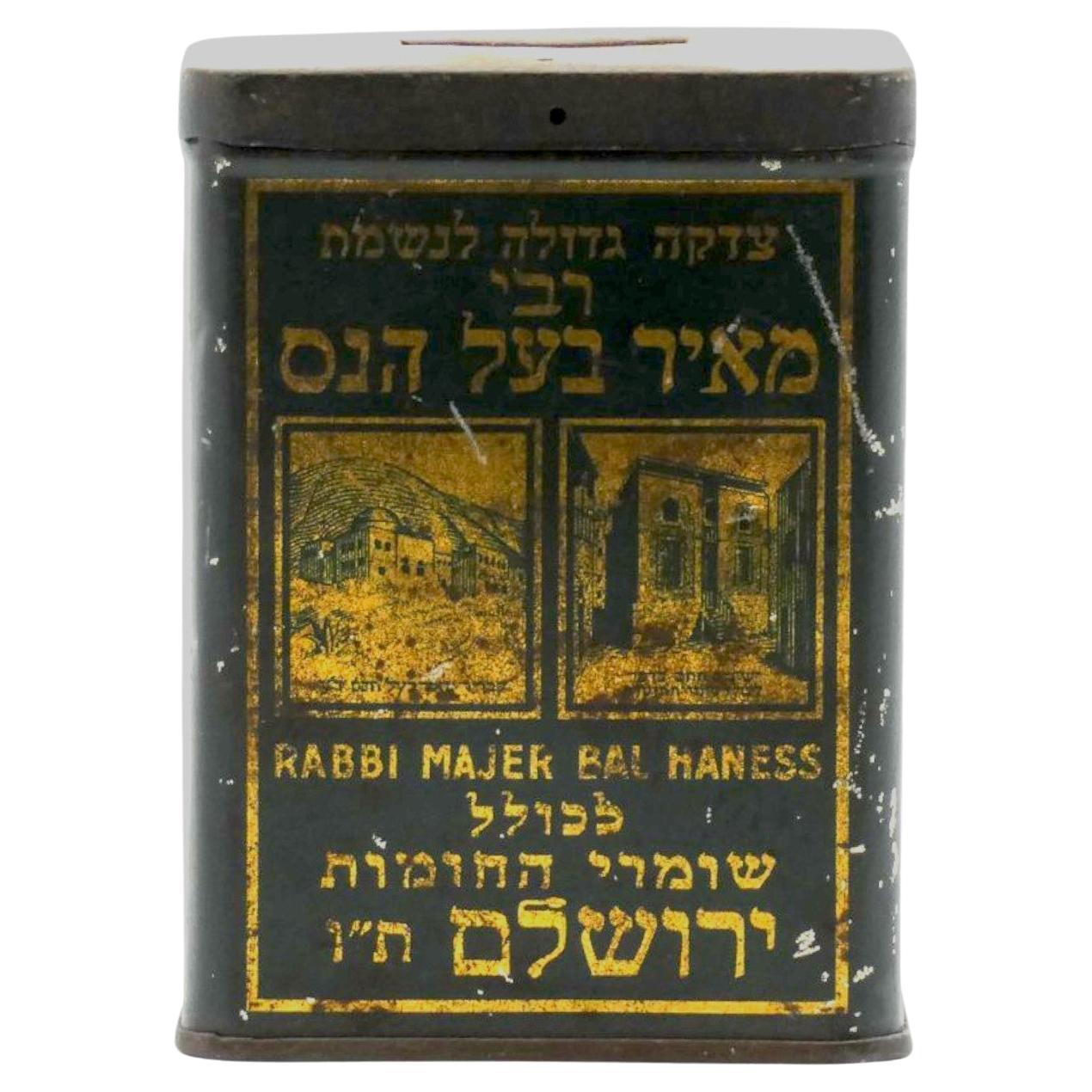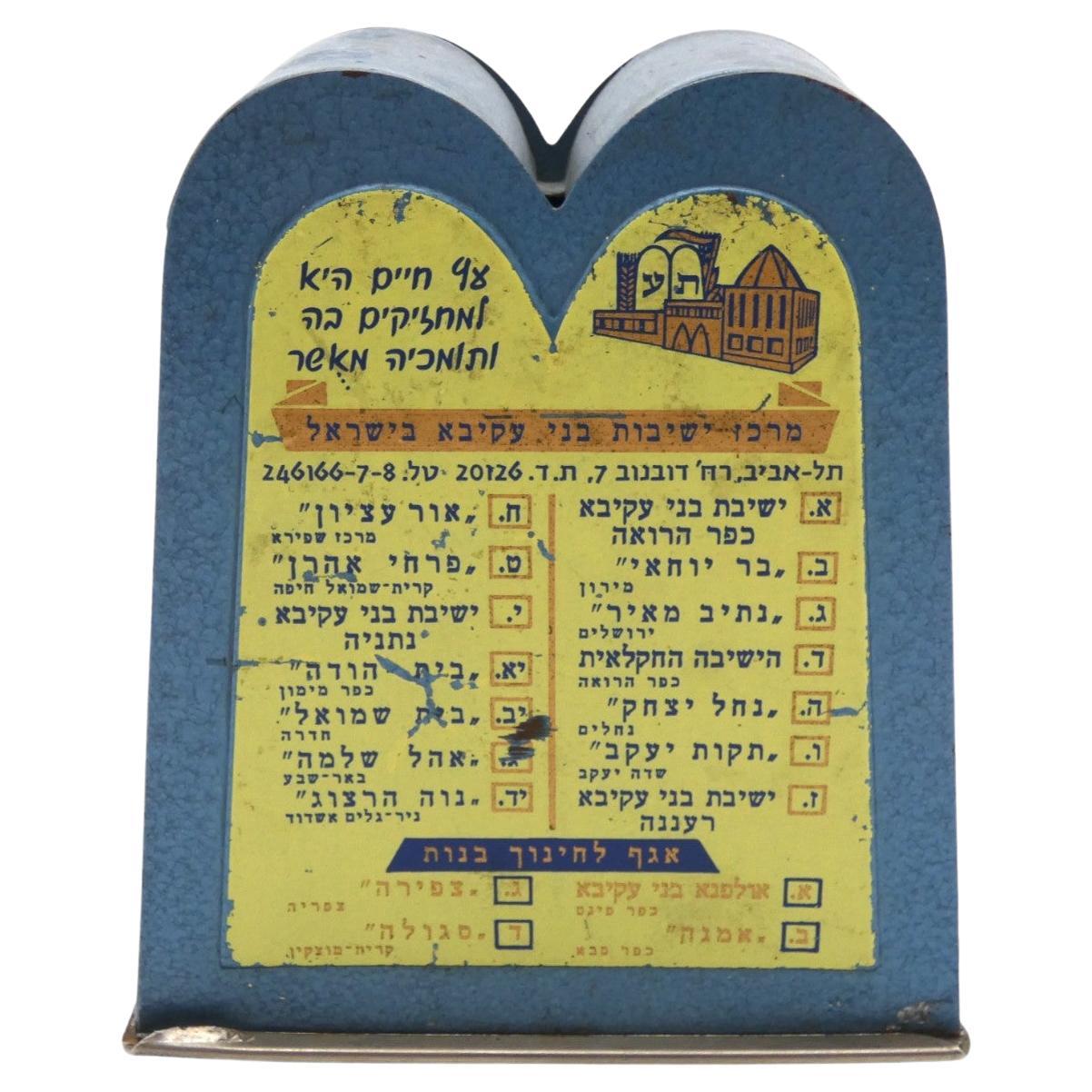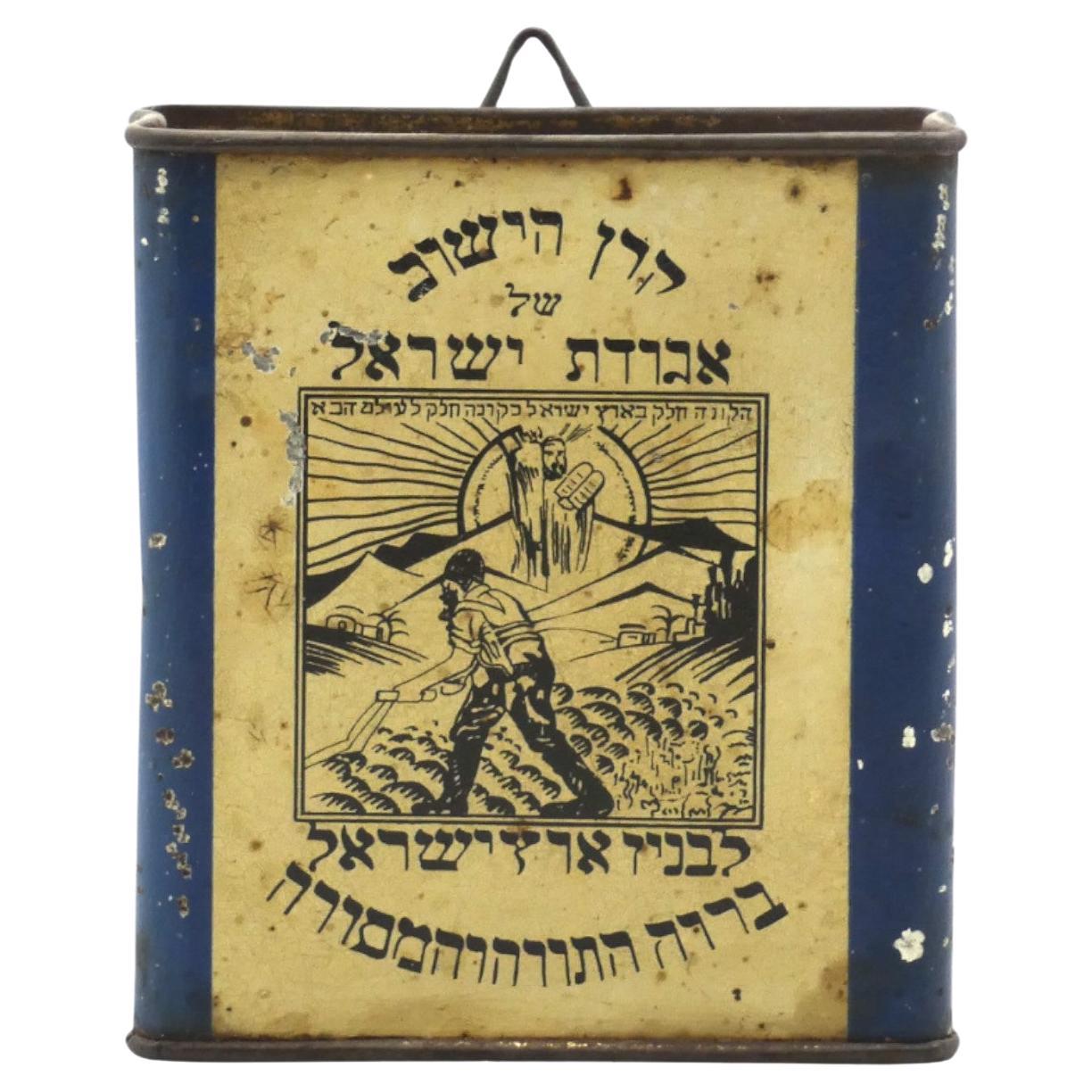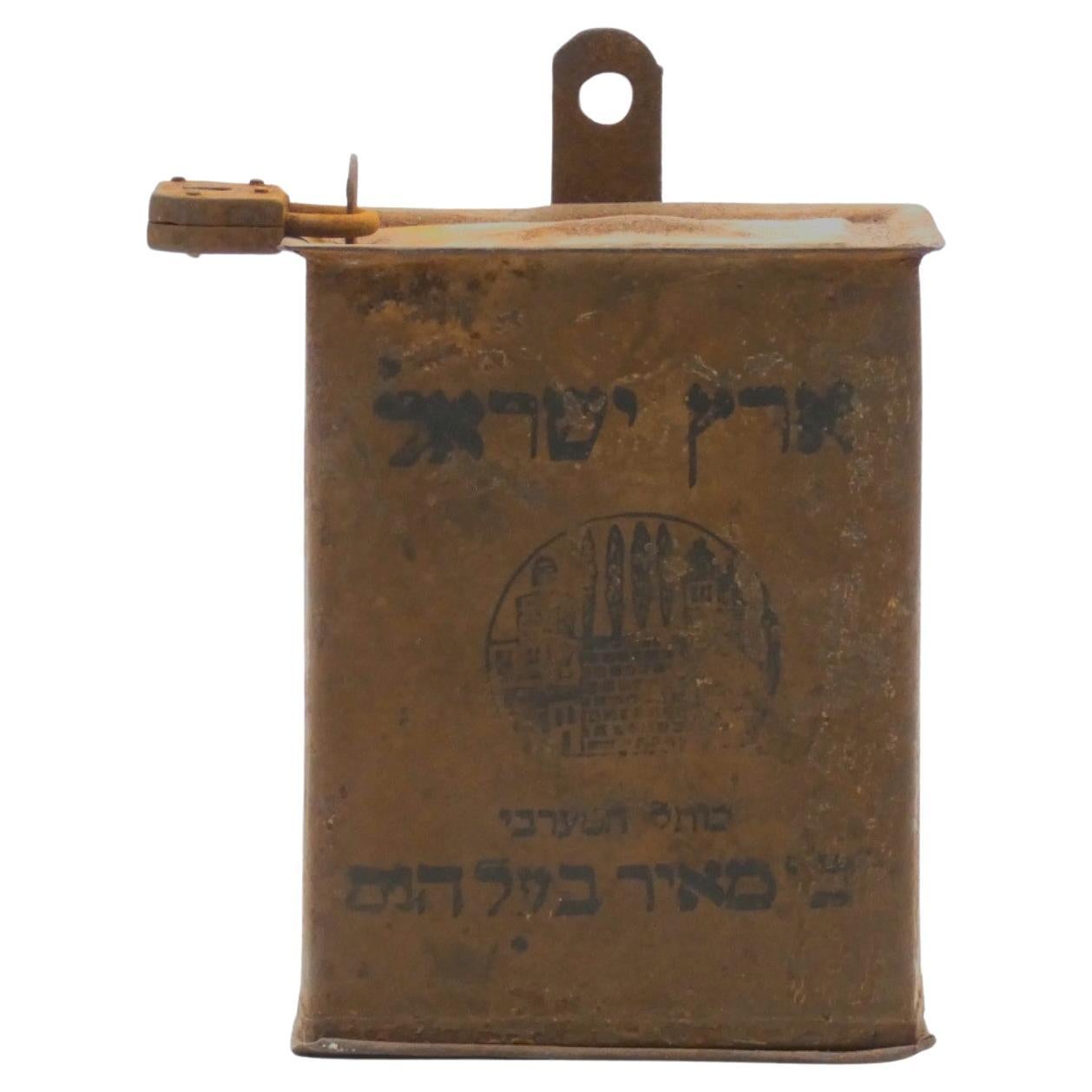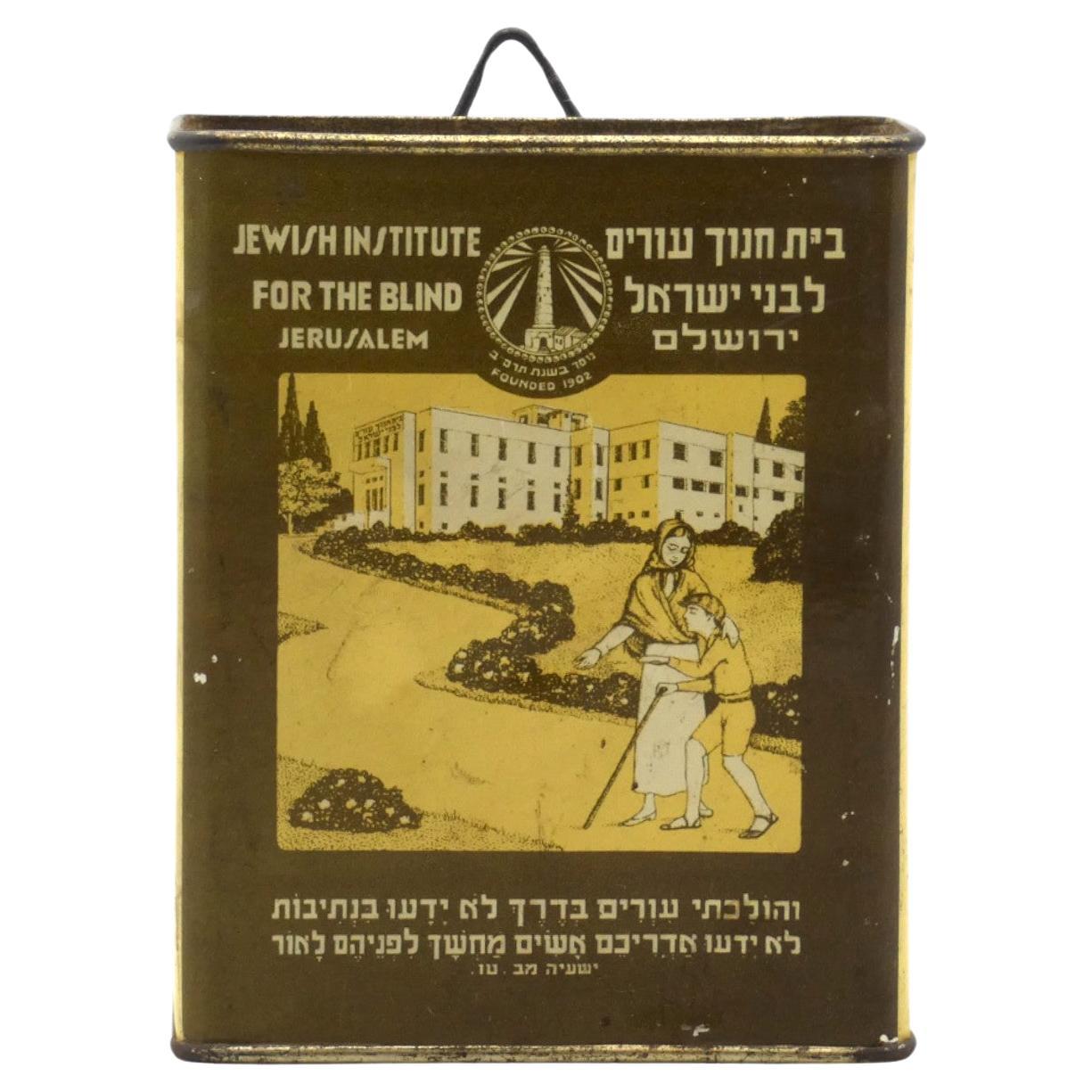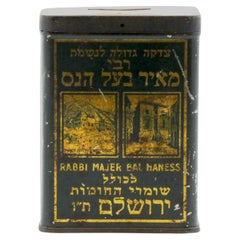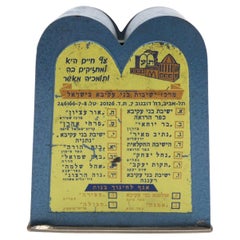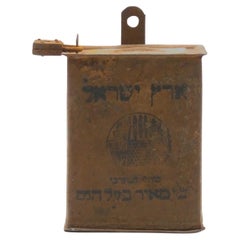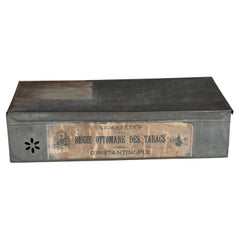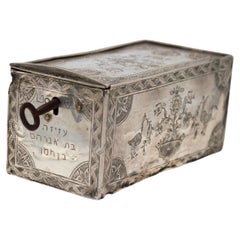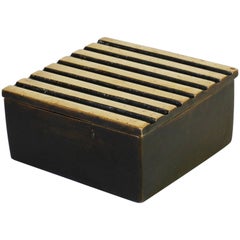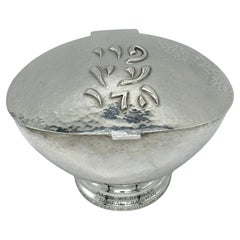Items Similar to Mid-20th Century Tin Charity Container by Alfred Zaltsman, Jerusalem
Want more images or videos?
Request additional images or videos from the seller
1 of 8
Mid-20th Century Tin Charity Container by Alfred Zaltsman, Jerusalem
$1,200
$1,50020% Off
£916.74
£1,145.9220% Off
€1,053.12
€1,316.4020% Off
CA$1,718.08
CA$2,147.6020% Off
A$1,879.38
A$2,349.2320% Off
CHF 979.18
CHF 1,223.9820% Off
MX$22,613.22
MX$28,266.5220% Off
NOK 12,400.06
NOK 15,500.0820% Off
SEK 11,642.47
SEK 14,553.0920% Off
DKK 7,864.20
DKK 9,830.2520% Off
About the Item
The front of the box is inscribed with Hebrew and German: "Rabbi Meir Baal Ha' Ness charity collecting funds for Shomrei Ha' Chomot Kolel" and decorated with two images; Hatam Sofer Yeshiva and the Tomb of Rabbi Meir Baal Ha' Ness.
Hebrew and German text are inscribed on both sides with information about the committee and its purposes, and the back marked with the makers mark.
The top with a slot for inserting the money and the bottom with a hinged door for withdrawing the money (no key).
This box was designed and signed by Alfred Zaltsman from Jerusalem who was a teacher at the Bezalel school of arts in Jerusalem.
Tzedakah is a Hebrew word commonly translated as charity, however the word is more closely connected to the English word justice. Tzedakah refers to a Jewish obligation to contribute to the creation of a just world. It is important to note that tzedakah is not only money, but refers to any act that creates a more just world. Giving tzedakah is so important that is considered one of three acts – along with repentance and prayer – that can save a person from death.
- Dimensions:Height: 4.73 in (12 cm)Width: 3.75 in (9.5 cm)Depth: 1.97 in (5 cm)
- Materials and Techniques:
- Place of Origin:
- Period:
- Date of Manufacture:circa 1930
- Condition:
- Seller Location:New York, NY
- Reference Number:1stDibs: LU5281219359602
About the Seller
5.0
Recognized Seller
These prestigious sellers are industry leaders and represent the highest echelon for item quality and design.
Established in 2006
1stDibs seller since 2020
141 sales on 1stDibs
Typical response time: 7 hours
- ShippingRetrieving quote...Shipping from: New York, NY
- Return Policy
Authenticity Guarantee
In the unlikely event there’s an issue with an item’s authenticity, contact us within 1 year for a full refund. DetailsMoney-Back Guarantee
If your item is not as described, is damaged in transit, or does not arrive, contact us within 7 days for a full refund. Details24-Hour Cancellation
You have a 24-hour grace period in which to reconsider your purchase, with no questions asked.Vetted Professional Sellers
Our world-class sellers must adhere to strict standards for service and quality, maintaining the integrity of our listings.Price-Match Guarantee
If you find that a seller listed the same item for a lower price elsewhere, we’ll match it.Trusted Global Delivery
Our best-in-class carrier network provides specialized shipping options worldwide, including custom delivery.More From This Seller
View AllA Tin Charity Container, Belgium Early 20th Century
Located in New York, NY
A tin charity container for Kollel Shomrei HaChomot in Belgium from the early 20th century was used to collect donations for this religious institution comprising several schools, an...
Category
Early 20th Century Belgian Religious Items
Materials
Tin
$1,200 Sale Price
20% Off
A Charity Container for the Bnei Akiva Organization , Israel 1950
Located in New York, NY
A charity container for the Bnei Akiva organization in Israel from around 1950 reflects the ethos and activities of this prominent religious Zionist youth movement.
Bnei Akiva is a ...
Category
Vintage 1950s Israeli Religious Items
Materials
Metal
$1,120 Sale Price
20% Off
A Keren Hayeshuv Charity Container, Israel Circa 1940
Located in New York, NY
A Keren Hayeshuv charity container from Israel circa 1940 is an artifact tied to the early years of the State of Israel and its efforts to support Jewish settlement and development.
Keren Hayeshuv, which translates to "The Settlement Fund," was an organization established in Israel during the pre-statehood period and continued its activities after the establishment...
Category
Vintage 1940s Israeli Religious Items
Materials
Tin
A Metal Israeli Kotel Charity Container, 1910
Located in New York, NY
A Rare Metal Israeli Kotel charity container for Rabbi Meir Baal Haness from 1910 tied to Jewish religious and charitable traditions.
Rabbi Meir Baal Haness, also known as Rabbi M...
Category
Vintage 1910s Israeli Religious Items
Materials
Metal
$2,000 Sale Price
20% Off
A Charity Container For Jewish Institute for the Blind by Alfred Saltzman, 1930
Located in New York, NY
A charity container for the Jewish Institute for the Blind by Alfred Saltzman from Jerusalem in 1930 reflects the efforts to support education and welfare for visually impaired indiv...
Category
Vintage 1930s Israeli Historical Memorabilia
Materials
Tin
$1,760 Sale Price
20% Off
A Kollel America Charity Container, New York Circa 1930
Located in New York, NY
A Kollel America Tiferet Jerusalem Charity Container from New York circa 1930 is tied to the charitable activities of Jewish immigrant communities in America raising donations for ca...
Category
Early 20th Century American Religious Items
Materials
Tin
$720 Sale Price
20% Off
You May Also Like
Large Antique Tobacco Tin Box, 1930s 1940s
Located in Greven, DE
Antique Tobacceo Box from France.
Category
Vintage 1930s French Decorative Boxes
Materials
Tin
extremely rare Algerian Judaica silver, jewish Dowry box early 19th century
Located in Tel Aviv - Jaffa, IL
Amazing and scarce JUDAICA object, we have here one of the most touching jewish objects we had for a long time, this small silver dowry box was made in Algeria in the early 19th century, it is all covered with symbols of jewish faith and of couples, the sliding lid has 2 flanking birds with hamsa (protective hand) on each side and a flower vase in the middle.
one side shows two flanking lions with a tree in the middle and the other side shows again two big and two small birds with a flower bowl in the middle, front side has a key hole and next to it there is the Hebrew inscription ס״ט״" which says Siman tov or in English "a good sign" it is taken from the wedding blessing, underneath the lock there is another inscription with the name ״עזיזה בת אברהם בן חמו״ which is the name of the bride, her father and her grandfathers name.
the box is full marked a lot of times with the silversmith mark, every side of the box is marked.
this box was probably ordered by the grooms family to hold the jewelry they are giving to the bride as dowry, this type of objects are rare and there are just a few of them on museum collections.
DOWRY (Heb. נְדֻנְיָה), the property a wife brings to her husband at marriage; the Yiddish equivalent, nadn, is from the same root. The custom of nedunyah became clearly defined and institutionalized only in the talmudic period. In biblical times, mohar (מֹהַר), whereby the groom bought his wife from her father (Gen. 24:53; Ex. 22:15–16; Hos. 3:2), was the accepted practice. It was then customary that the groom give the bride gifts, and that she bring certain property to her husband's home upon marriage: slaves, cattle, real estate, etc. (cf. Gen. 24:59–61; 29; Judg. 1:14ff.; I Kings 9:16). Evidence of the custom of nedunyah is to be found in Tobit (7:14; 8:21) and in the Assuan papyri (Cowley, Aramaic, nos. 15, 18). Gradually, mohar was superseded by the ketubbah custom according to which the husband merely assumed the responsibility of compensation to his wife in case he divorced her: he had to pay her 200 zuzim if she had been a virgin at the time of marriage, and 100 zuzim if a widow or divorcée (see *Ketubbah).
By talmudic times, the institution of nedunyah was prevalent; the father gave a dowry to the bride since the daughter was excluded from paternal inheritance. Fifty zuzim (equivalent to the worth of 180 grams of silver) was the minimum amount a father was obliged to give to his daughter (Ket. 6:5). Parents usually gave much more, according to their social standing. Community funds provided the dowry for an orphan or a very poor girl (ibid.; cf. Sh. Ar., YD 251:8). In case of her father's death, the brothers of a minor girl were obliged to give her the minimum dowry, and the court estimated how much her father would have given her above the minimum dowry. The sum was then taken out of the father's estate and given to the daughter upon majority (Ket. 6:6; 68a–69b). In the absence of such an estimate, each daughter was entitled to receive one-tenth of the value of her father's estate in money, or in valuables (Yad, Ishut, 20:4–7; Sh. Ar., EH 113:4). If the father was unable or unwilling to pay the promised dowry at the betrothal ceremony, the groom could refuse to marry his bride (Ket. 13:5; Ket. 108b–109a). Insistence on exact payment of the promised dowry, however, was frowned upon by later rabbinic authorities (Rema to Sh. Ar., EH 2:1). In certain communities it was customary for the groom's father to make a dowry contribution equal to that of the bride's father (Ket. 102b). The dowry, whether given in real estate, slaves, money, or chattel was recorded in the marriage contract (the ketubbah) and in some instances one-third or one-fifth of the actual value of the dowry was added to the sum mentioned in the ketubbah. Based upon a decree enacted by *Simeon b. Shetah (first century C.E.), the Talmud ruled that the husband and his entire property were liable for compensation as stipulated in the ketubbah, either in case he died (when she collected the sum specified in the ketubbah from the heirs) or in case he divorced his wife (Ket. 82b). For the status of the dowry and the husband's rights and obligations, see below. The rabbinic enactments (Takkanot Shum) by R. Jacob *Tam and by the rabbinic synod of the communities of Speyer, Worms, and Mainz (Germany) stipulated that if a woman died...
Category
Antique Mid-19th Century Algerian Tribal Art
Materials
Silver
Extremely Rare Austrian Cigarette Box or Tin Signed by Walter Bosse, circa 1951
By Walter Bosse
Located in Landau an der Isar, Bayern
An extremely rare brass box or tin designed by Walter Bosse for storing cigarettes or tobacco in.
We have yet to find this example in any publication on Bosse's work although simila...
Category
Vintage 1950s Austrian Mid-Century Modern Cigar Boxes and Humidors
Materials
Brass
$2,100 Sale Price
40% Off
JUDAICA SILVER ETROG BOX DESIGNED BY LUDWIG WOLPERT. New York, 20th century
Located in Tel Aviv - Jaffa, IL
This charming piece of jewish history in front of you is a one of kind modern Judaica object,
This box used to hold the Etrog To protect the it during the holiday of Sukkot, it is traditionally Wrapped in silky flax fibers and stored in a special decorative box, mostly made from silver.
Wolpert designed this amazing hand hammered Bauhaus style box in 1963-1964 while he was Working in New York. all of the boxes we could found from this design made by Wolpert have The upper part inscribed in a simple engraving with the phrase "Pri Etz Hadar"
In Hebrew ״פרי עץ הדר״. the box in front of you is the only example in existence as far as we Know where the letters are also repoussé and also engraved, such a beautiful and hard to get Combination, the rest of the box is shaped as a modernistic Etrog, all the body of the box is Skillfully hand hammered in a way it reflects the light in a warm and calm way, a true Masterpiece of modern judaica by the great and important artist Ludwig Yehuda Wolpert.
One of the the two great masters of 20th century Judaica.
the Box is marked "WOLPERT" AND "STERLING" and the base has the engraved inscription :
"ALAN WECHSLER GENERAL CHAIRMAN, ALLIED JEWISH APPEAL OF SOUTHERN NEW JERSEY 1978"
Similar boxes can be find in museum collections around the world
In the Jewish Museum New York
In the North Carolina Museum of Art
In The Derfner Judaica Museum
Another similar box was featured in the Israel Museum exhibition
"Forging Ahead, Wolpert and Gumbel, Israeli Silversmiths for the Modern Age"
Ludwig Yehuda Wolpert was born in Hildesheim, Germany, to an Orthodox family. In 1916-1920, He began his studies in sculpture at the Frankfurt School of Art. In 1925-1928, he studied Goldsmithing at the Frankfurt School of Art.
Following the presentation of the works in the 1930 exhibition "Kult und Form" ("Ritual and Form") at the Jewish Museum in Berlin, his works became well known in the German Jewish World. His works were greatly influenced by Modernist design, especially the Bauhaus Movement. Wolpert's works avoid decoration, relying on clean, geometric shapes. In 1933, Following the Nazi rise to power in Germany, he immigrated to the Mandatory Palestine with His family. There he worked for two years in the workshop of Bernhard Friedländer, where he Designed and produced silverware and Jewish ceremonial art.Together with Victor Solomon...
Category
Vintage 1960s Decorative Boxes
Materials
Silver
19th Century Toleware Grocer’s Shop Tea Tin
Located in Godshill, Isle of Wight
19th century toleware grocer’s shop tea tin,
A beautiful decorative Grocers Tea Canister, it would have been filled with Tea for sale, it has a very attractive style. The lid is...
Category
Antique Late 19th Century Arts and Crafts Tea Caddies
Materials
Tin
Large 1930s Tin Box "Kaffee-Schilling", Schilling & Sohn Bremen Vintage Tin Can
Located in Greven, DE
Antique Tin Box from "Kaffee-Schilling" Bremen.
Category
20th Century German Decorative Boxes
Materials
Tin
More Ways To Browse
Jerusalem Furniture
Metal Container
Money Box
Vintage Metal Container
Vintage Metal Containers
Vintage Tin Paint Box
Vintage Decorative Tin Containers
Antique Pine Boxes
Antique Quilling
Antique Rosewood Box
Chinese Vintage Boxes
French Enamel Boxes
Antique Writing Box
Green Box Vintage
Plastic Vintage Box
Antique Chinese Lacquer Box
Filipino Box
Antique Chinese Lacquer Box Boxes
